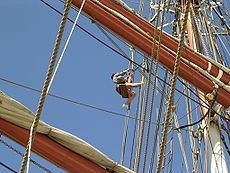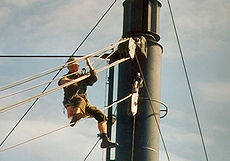
Bosun's chair
Encyclopedia


Climbing harness
A climbing harness is a piece of equipment used in certain types of rock-climbing, abseiling or other activities requiring the use of ropes to provide access or safety...
by the inclusion of a more or less rigid seat, providing more comfort than even the best-padded straps for long-term use. In exchange, the bosun's chair does not allow the freedom of movement necessary for climbing, and the occupant is generally hoisted or lowered into place using the rope alone.
Some bosun's chairs consist of little more than a short plank and a suitable set of ropes to suspend it from; these are usually used with a separate harness in case the user should slip off the plank. Other bosun's chairs, particularly the type commonly carried on yachts for masthead repair, incorporate more straps so that the wearer cannot fall out, though they still include a rigid or semi-rigid seat.
As well as on ships and boats where they originated, bosun's chairs are also used for working at height on buildings and other structures
Architectural structure
An architectural structure is a free-standing, immobile outdoor constructed element. The structure may be temporary or permanent.Structures include buildings and nonbuilding structures . Examples of building structures include houses, town halls, libraries, and skyscrapers...
. In commercial window cleaning, the term 'bosun's chair' is used for other devices suspended from rope and equipped with seatboards, such as controlled descent apparatus (CDAs). However, CDAs cannot be raised and lowered like a true bosun's chair, and can be used for descent only.
Competition
Bosun's Chair has also become a competition in Sea Scout Regattas around the country such as the Old Salt's Regatta and the Ancient Mariner's Regatta. The event requires a line running through a block connected to a tower, simulating a ship's mast. Two participants approach the line and prepare it for the event. When ready, the participants stand at attention. On the signal from the judges time starts. One person ties into one side of the line using a french bowline. The person places one loop around their waist and the other under their legs. The other person gets ready to pull the first person up to the block. When the person who is tied in reaches the top and touches the block they yell touch. Time then stops and they are slowly lowered to the ground. As soon as the person touches the ground or the two participants touch each other time begins. The first person unties and the second person ties in. The second person is raised to the top, time stops, and they are lowered. Time again starts when the person touches the ground or their partner, and is stopped finally when the knot is untied, and the participants stand at attention again. A competitive time is at least under one minute for the entire operation.Safety
The competition judges are in charge of safety. If the french bowline is tied wrong or does not have the six inches of tail required, safety will be called and with time running, they will have to fix this. Another reason to call safety is if the loops of the french bowline are not in the right places or are too loose. If the descent is not done in controlled a hand over hand method, the team will be disqualified.Variations
At the Old Salt's regatta, the bosun's chair is an eight-person competition. Instead of multiple teams of two competing, the entire team lines up for the event. The first person ties in while the second person raises them. Once they touch the ground, the first person unties and is done. The second person then ties in and is lifted by the third person. This continues until the final person lifts someone and the second to last person is lifted, unties and the crew returns to attention.History
This event is based on a practice from old navy ships. High ranking officers would be lifted onto the ships instead of climbing on board. The bosun's chair would be attached to a block on the davitDavit
A davit is a structure, usually made of steel, which is used to lower things over an edge of a long drop off such as lowering a maintenance trapeze down a building or launching a lifeboat over the side of a ship....
with a line. The officer would have the chair put under him, or the french bowline tied around him, and then sideboy
Sideboy
A side boy is a member of an even-numbered group of seamen posted in two rows at the quarterdeck when a visiting dignitary boards or leaves the ship, historically to help him aboard, presently as a ceremonial guard of honour, in a ceremony known as tending the Side. Side boys are instructed by the...
s would lift him onto the deck of the ship on the command of the bosun's whistle. Since higher ranking officers were often richer and therefore heavier, they naturally needed more people to lift them. This is where the practice of having more sideboys for higher ranking officers comes from this in the navy.
Knots that can be used for a Bosun's Chair
- French Bowline
- Spanish bowlineSpanish BowlineA double loop knot that can be used to lift a person. For a conscious person, each loop is placed around a leg and the person holds onto the standing part of the rope. This knot can serve as a makeshift Bosun's chair...
- Fireman's chair knotFireman's chair knotA fireman's chair knot is a knot tied in the bight forming two adjustable, lockable loops. The knot consists of a handcuff knot finished with a locking half hitch around each loop...
- Bowline on a bightBowline on a bightThe Bowline on a bight is a knot which makes a pair of fixed-size loops in the middle of a rope. Its advantages are that its loops do not slip and it is reasonably easy to untie after being exposed to a strain. This knot can replace the figure-eight knot when tying into a climbing harness...

